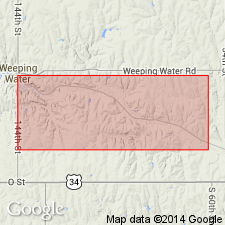
- Usage in publication:
-
- Weeping Water limestone
- Modifications:
-
- Original reference
- Dominant lithology:
-
- Limestone
Summary:
Pg. 154-172. Weeping Water limestone. Massive light-gray limestone, 9 feet thick, forming top member of Wabaunsee formation in Cass County [Nebraska].
Source: US geologic names lexicon (USGS Bull. 896, p. 2296).
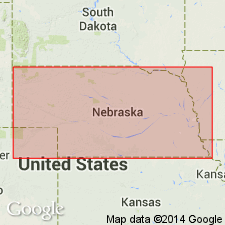
- Usage in publication:
-
- Weeping Water limestone member
- Modifications:
-
- Revised
- AAPG geologic province:
-
- Nemaha anticline
Summary:
Pg. 6, 10, 19. Weeping Water limestone member of Andrew (Lawrence) shale. Weeping Water limestone, lying 18 feet below top of Andrew (Lawrence) shale and 16 to 18 feet above Oreapolis limestone member of the Andrew, is 11 to 12 feet thick in exposures west of La Platte and Oreapolis, in Platte section, and 6 to 8 feet thick near Plattsmouth, in Missouri River section. Is light-colored. In Platte section it consists of 2 beds separated by 1 foot of light-colored calcareous shale. Fossiliferous (crinoid stems, fusulinids, bryozoans, and brachiopod fragments). Age is Pennsylvanian. Report includes measured sections, cross sections.
Source: US geologic names lexicon (USGS Bull. 896, p. 2296-2297); GNC KS-NE Pennsylvanian Corr. Chart, sheet 1, Oct. 1936; supplemental information from GNU records (USGS DDS-6; Denver GNULEX).
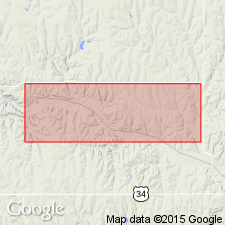
- Usage in publication:
-
- Weeping Water limestone
- Modifications:
-
- Areal extent
- AAPG geologic province:
-
- Nemaha anticline
Summary:
Pg. 34. Weeping Water limestone (in Andrew shale), is exposed in valley sides of Weeping Water Creek in secs. 4, 5, 6, 9, and 10, T. 10 N., R. 12 E., and along west side of North Branch Valley about 1 mile northwest of Nehawka [Cass County, Nebraska]. Thickness 6 feet. Is light-colored, massive, breaks down in large blocks, and shows tendency to weather into rough, nodular forms. Is overlain and underlain by shale. Age is Pennsylvanian.
Source: US geologic names lexicon (USGS Bull. 896, p. 2296-2297); GNC KS-NE Pennsylvanian Corr. Chart, sheet 1, Oct. 1936.
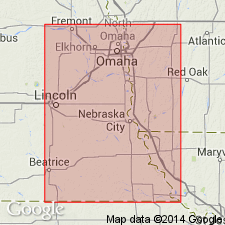
- Usage in publication:
-
- Weeping Water limestone bed
- Modifications:
-
- Revised
- AAPG geologic province:
-
- Nemaha anticline
Summary:
Pg. 2297. Weeping Water limestone bed of Oread limestone member of Douglas formation. Is now known to be lowest unit of Oread limestone. The overlying shale is here named Snyderville shale. The underlying beds are Lawrence shale. Age is Late Pennsylvanian (Missouri age). Report includes cross sections, measured sections, geologic maps, stratigraphic tables.
[This definition was adhered to by R.C. Moore and G.E. Condra in their Oct. 1932 revised classification chart of Pennsylvanian rocks of Nebraska and Kansas, and by Condra in his 1935 classification (Nebraska Geol. Survey Paper, no. 8, p. 12).]
Source: US geologic names lexicon (USGS Bull. 896, p. 2296-2297); GNC KS-NE Pennsylvanian Corr. Chart, sheet 1, Oct. 1936; supplemental information from GNU records (USGS DDS-6; Denver GNULEX).
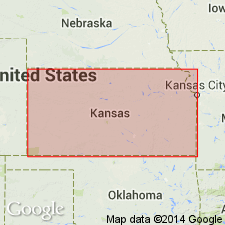
- Usage in publication:
-
- Weeping Water limestone
- Modifications:
-
- Areal extent
Summary:
Pg. 163. There is sufficient doubt as to equivalence of "lower Oread" limestone of Kansas and Weeping Water limestone of Nebraska to make use of latter name undesirable for a subdivision of Kansas Oread. The basal member of Kansas Oread is therefore here named Toronto limestone member, a name introduced by Haworth and Piatt in 1894. [Oread limestone is basal formation of Shawnee group.]
Source: US geologic names lexicon (USGS Bull. 896, p. 2297); GNC KS-NE Pennsylvanian Corr. Chart, sheet 2, Oct. 1936.
For more information, please contact Nancy Stamm, Geologic Names Committee Secretary.
Asterisk (*) indicates published by U.S. Geological Survey authors.
"No current usage" (†) implies that a name has been abandoned or has fallen into disuse. Former usage and, if known, replacement name given in parentheses ( ).
Slash (/) indicates name conflicts with nomenclatural guidelines (CSN, 1933; ACSN, 1961, 1970; NACSN, 1983, 2005, 2021). May be explained within brackets ([ ]).

